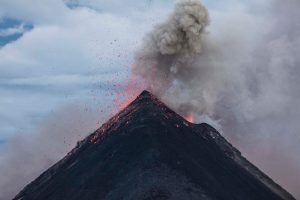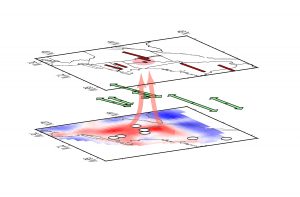
Scientists involved in a New Jersey-based Rutgers University study believe a volcano is forming under New England. But don’t pack your bags yet; while they’ve identified an enormous mass of warm rock slowly rising under New England, they believe a major volcanic eruption isn’t likely for millions of years. The groundbreaking study, just published in the journal “Geology”, challenges textbook concepts of geology and an understanding of how the mountains in the northeast have formed.
In an abstract, study scientists wrote, “Highly localized variation in the strength of seismic anisotropy in a region of strongly elevated asthenospheric temperature suggests the presence of a narrow thermal upwelling in the upper mantle beneath New England. The lack of obvious surface expressions (volcanism or uplift) and the small lateral scale of the hypothesized upwelling suggest a geologically recent phenomenon.” In lay terms, the scientists discovered a warm, rising mass deep beneath New England, and like a rising hot air balloon, is moving to the surface.

Image: Vadim Levin/Rutgers University-New Brunswick
The study, which tapped seismic data through the National Science Foundation’s EarthScope program, was published online this week in Geology. Study co-authors include Yiran Li and Peter Skryzalin, who did their research through Rutgers’ Aresty Research Assistant Program. Researchers at Yale University also contributed to the work.
The EarthScope programs collects a tremendous amount of information from thousands of different monitoring devices positioned all over the United States. As the largest-scale seismic measurement system in the country, EarthScope is providing scientists with a better understanding of the geology and seismology on the continent.
EarthScope’s measurements show that the upwelling is occurring deep beneath parts of Massachusetts, Vermont, and New Hampshire. While the study shows the core “blob” of warm rock is under central New Hampshire and Vermont, it is not known where a volcano would actually surface. The timing of such a volcanic eruption is also hard to pin-down, although project scientists believe such an event is more than a million years away.
Volcanoes have returned to headlines recently around the world. The Agung volcano continues to erupt in Indonesia; the stratovolcano there may impact climate and weather for months and years to come. In Iceland, recent seismic activity at Oraefajokull have experts in North America and Europe concerned; an eruption there could put a damper on air travel between the continents and within Europe, above and beyond impacts to weather and climate too.
The full article about this New England volcano possibility appears in Geology here.